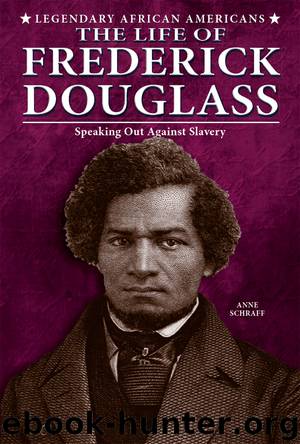The Life of Frederick Douglass by Anne Schraff

Author:Anne Schraff [Schraff, Anne]
Language: eng
Format: epub
ISBN: 9780766061347
Publisher: Enslow Publishers, Inc.
Published: 2014-03-21T16:00:00+00:00
Chapter 7
FIGHTING FOR FREEDOM
Harriet Beecher Stowe criticized William Lloyd Garrison for his anger toward Frederick Douglass. She scolded him for speaking of Douglass as an “apostate” who had given up his principles.1 Stowe, along with many other abolitionists, feared the harm disunity was doing to the movement.
But the disagreements were too real to be papered over. Garrison fervently believed that violence was never an option. In 1849, Frederick Douglass was telling audiences that a slave revolt might be necessary to end slavery. Garrison saw the United States Constitution as a pro-slavery document that could never be used to serve the goals of abolition. Garrison called the Constitution “a covenant with death and an agreement with hell” and publicly burned the document to make his point.2 Douglass wanted to make political appeals for abolition that would use the principles within the Constitution. The only means Garrison saw to end slavery was to convince people that it was morally wrong. Douglass feared that Americans could never be convinced by moral appeals to their better natures. With such deep differences, the two men could not reconcile.
In 1857, the United States Supreme Court affirmed the right of a slave owner to reclaim his slave even if the slave had fled to a free part of the country and now lived there. This decision in the Dred Scott case enraged Douglass and he called it “devilish,” vowing that it would not stand.3
During the 1840s, Douglass had met with a fiery white abolitionist named John Brown. Douglass found in Brown a good friend because of his passionate hatred of slavery. During the 1850s, Brown was a frequent visitor at the Douglass home. In 1859, Brown laid plans to lead an attack on the northern Virginia town of Harpers Ferry, seize weapons in the federal arsenal, and hold local citizens hostage while he organized a slave rebellion in the area. Brown discussed the plan with Douglass. Douglass was sure it was doomed. After meeting with Brown and his small group of followers, Douglass grew even more pessimistic about the chances for success in a raid on Harpers Ferry. He told Brown that he was going into “a perfect steel trap” and that he and his men would be blown “sky high.”4 Brown continued to ask for Douglass’s help, but Douglass turned him down.
On October 18, 1859, Brown led his army of twenty-two men on Harpers Ferry and seized the arsenal. The next night federal troops led by Colonel Robert E. Lee stormed the armory where Brown and his men were barricaded, capturing Brown, killing one of his sons, and ending the rebellion.
Douglass was lecturing in Philadelphia when he learned of Brown’s capture. He also learned that the federal troops found a note from Douglass on one of Brown’s men. The governor of Virginia immediately tried to implicate Douglass in the conspiracy against Harpers Ferry. He asked President James Buchanan to assist in arresting all of Brown’s allies, including Frederick Douglass. Douglass was to be charged with inciting servile insurrection.
Download
This site does not store any files on its server. We only index and link to content provided by other sites. Please contact the content providers to delete copyright contents if any and email us, we'll remove relevant links or contents immediately.
Pocahontas by Joseph Bruchac(3724)
Adulting by Kelly Williams Brown(3671)
Unfiltered by Lily Collins(3612)
In the Shadow of Liberty by Kenneth C. Davis(3132)
Earthrise by Edgar Mitchell(2758)
Almost Adulting by Arden Rose(2297)
Charlie and the Chocolate Factory (Puffin Modern Classics) by Roald Dahl(2027)
Fierce by Aly Raisman(1855)
The Audition by Maddie Ziegler(1814)
Borders by unknow(1786)
I Will Always Write Back by Martin Ganda(1766)
Women in Science by Rachel Ignotofsky(1409)
The Day the President Was Shot by Bill O'Reilly(1368)
Amelia Earhart by Doris L. Rich(1339)
The Last Days of Jesus by Bill O'Reilly(1261)
God's Smuggler by Brother Andrew(1219)
Redefining Realness by Janet Mock(1216)
Extraordinary, Ordinary People by Condoleezza Rice(1207)
Popular: Vintage Wisdom for a Modern Geek by Maya Van Wagenen(1152)
